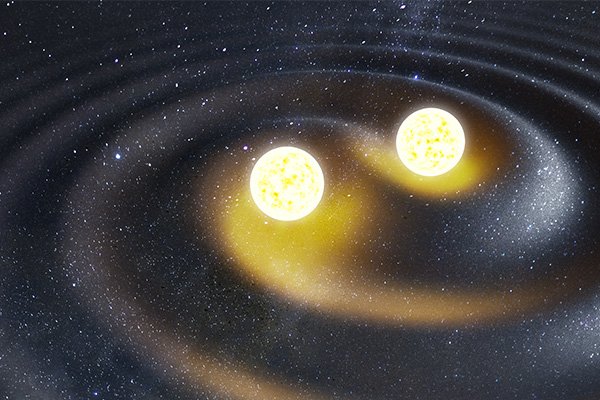30-Second Alert: Astronomers to Receive Gravitational Wave Notifications
Key Takeaway
A team of researchers at the University of Minnesota is developing software that will enable astronomers to receive alerts about gravitational wave events within 30 seconds of detection, allowing for prompt follow-up observations of events such as neutron star collisions.
Summary
- Gravitational waves are disturbances in the fabric of space-time caused by massive cosmic events like collisions between black holes and neutron stars.
- The LIGO-Virgo-KAGRA observatories use interferometers to detect these gravitational waves by measuring minute changes in the lengths of perpendicular laser beams.
- Researchers at the University of Minnesota are working on software that can analyze gravitational wave data and send alerts to astronomers within 30 seconds of detection.
- This rapid alert system will enable astronomers to pinpoint the location of events like neutron star collisions and study the associated electromagnetic emissions.
- The software will also provide estimates of the properties and characteristics of the colliding objects that generated the gravitational waves.
- Studying neutron star collisions can help answer outstanding questions about their formation and the production of heavy elements like gold and uranium.
- The LIGO observatory has completed its latest observation run, and the next run is scheduled for February 2025, during which the new alert system will be operational.
- Improvements and enhancements have been made to increase the sensitivity of the detectors between observation runs.

The Race for Gravitational Wave Alerts
In the vast expanse of the cosmos, monumental events like the collision of black holes and neutron stars create ripples in the fabric of space-time itself, known as gravitational waves. These elusive signals have long been a holy grail for astronomers, offering a unique window into the most extreme environments in the universe. However, capturing these fleeting waves has been a daunting task, often requiring extraordinary precision and timing. That’s where a team of researchers at the University of Minnesota comes in, developing a groundbreaking system that promises to revolutionize the way we observe and study these cosmic phenomena.
At the heart of this ambitious project lies a seemingly simple goal: to alert astronomers about detected gravitational wave events within a mere 30 seconds. While this may sound like a trivial feat, the implications are profound. By receiving these near-real-time alerts, astronomers can swiftly train their telescopes on the source of the gravitational waves, potentially witnessing the aftermath of cataclysmic events like neutron star collisions.
But first, let’s delve into the nature of gravitational waves themselves. These elusive signals are disturbances in the very fabric of space-time, caused by the acceleration of massive objects like black holes and neutron stars. As these celestial bodies collide or merge, they release an enormous amount of energy in the form of gravitational waves, propagating outward at the speed of light.
Detecting these waves is no easy task. It requires instruments of unprecedented sensitivity, capable of measuring infinitesimally small distortions in space-time. This is where the LIGO (Laser Interferometer Gravitational-Wave Observatory), Virgo, and KAGRA observatories come into play, utilizing sophisticated interferometers to measure minute changes in the lengths of perpendicular laser beams.
While the detection of gravitational waves is a remarkable achievement in itself, the true potential lies in the ability to rapidly respond to these events. By receiving alerts within 30 seconds, astronomers can mobilize their resources and point their telescopes at the precise location of the event, capturing the aftermath in real-time.
One of the primary motivations for this rapid alert system is the study of neutron star collisions. These incredibly dense remnants of massive stars offer a unique laboratory for exploring the extremes of nuclear physics and the formation of heavy elements like gold and uranium.
By observing the electromagnetic emissions associated with neutron star collisions, astronomers can gain invaluable insights into the behavior of these exotic objects and the fundamental processes that govern their formation and evolution.
At the heart of this ambitious endeavor lies a sophisticated software system developed by the researchers at the University of Minnesota. This cutting-edge software is designed to analyze the incoming gravitational wave data in real-time, identifying the characteristic signatures of events like black hole and neutron star collisions.
But the software’s capabilities go beyond mere detection. It can also track the evolution of the gravitational wave signal over time, providing crucial insights into the properties and characteristics of the colliding objects. This information can then be rapidly disseminated to astronomers around the globe, enabling coordinated follow-up observations and maximizing the scientific impact of these rare and fleeting events.
As the LIGO observatory prepares for its next observation run in February 2025, the excitement surrounding this new alert system is palpable. With continuous improvements and enhancements to the detectors’ sensitivity, the chances of capturing and studying these cosmic ripples have never been greater.
The implications of this research extend far beyond the realm of gravitational wave astronomy. By unlocking the secrets of neutron stars and their collisions, we may unravel the mysteries of nuclear physics, the formation of heavy elements, and the very nature of matter under the most extreme conditions imaginable.
As astronomers eagerly await the first alerts from this groundbreaking system, one thing is certain: the cosmic stage is set for a new era of discovery, where the elusive whispers of gravitational waves will no longer go unheard.
HASHTAGS:
#GravitationalWaves, #NeutronStars, #BlackHoles, #LIGO, #Astronomy, #SpaceExploration, #CosmicCollisions, #RapidAlerts, #UniversityOfMinnesota, #GravityWaveDetection #Gravitational Wave Notifications
Source: Researchers Advance Detection of Gravitational Waves with Study of Collisions of Neutron Stars Link: Read more

